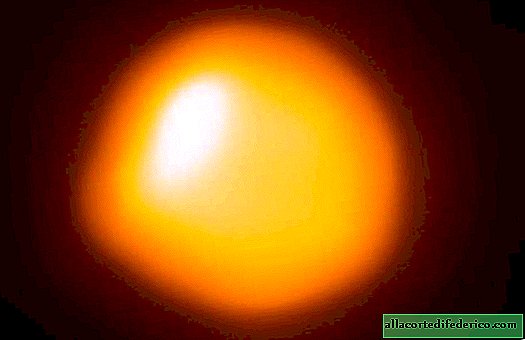Astronomers were the first to photograph a distant star in high resolution
Astronomers managed to get a high resolution image of the Betelgeuse star in the constellation Orion. This is the most detailed photo of a star outside the solar system to date, as well as the first shot taken by the ALMA telescope (Atacama Large Millimeter Array). Photography allowed to learn a lot about the distant star. For example, the fact that in the near future by space standards, it can explode.
A thousand times the sun
Betelgeuse is a red supergiant that is located at a distance of 643 ± 146 light years from Earth. The diameter of a star is about a thousand times larger than our Sun. According to scientists, if you place Betelgeuse in our system in place of the Sun, it will occupy space at least up to the orbit of Mars, and the maximum - up to the orbit of Jupiter. Due to the fact that she is the ninth brightest star in the night sky, she is considered an excellent target for research.

Photo: ALMA (ESO / NAOJ / NRAO) / E. O'Gorman / P. Kervella
The picture shows that the star and its atmosphere are heated unevenly. If at a distance of about 1.3 of its radii, the temperature is about 2760 Kelvin, then a large spot in the center of Betelgeuse can exceed it by 1000 Kelvin.

In the photo: Betelgeuse in comparison with the orbits of the planets of the Solar system / Source: ALMA (ESO / NAOJ / NRAO) / E. O'Gorman / P. Kervella
In recent years, Betelgeuse's apparent gloss has decreased by about 15%. Scientists believe that this may be due to the fact that its size is constantly changing, or due to distortion of observations due to irregular star shape. Finally, since the star is a red giant, she simply could have "old age". In this case, sooner or later Betelgeuse will explode, and a bright flash from its explosion will make the star visible from Earth even in the daytime sky. True, scientists cannot say exactly when this will happen - in a few years or in millennia.
The most expensive photographer in the world
ALMA (Atacama Large Millimeter Array) - a complex of radio telescopes located in the Chilean desert of Atacama. It consists of 66 antennas combined into a single astronomical radio interferometer (powerful radio telescope). Data from all antennas goes to a supercomputer, which processes them at a speed of 17 quadrillion operations per second.

In the photo: ALMA (Atacama Large Millimeter Array)
The observatory was officially opened in 2013. Its main task is to study the processes that took place during the first hundreds of millions of years after the Big Bang, when the first generation of stars was formed. With the help of ALMA, they plan to obtain new data explaining the mechanisms of evolution of the Universe.
Today it is the largest and most expensive astronomical project located on Earth. Its cost is estimated at 1.5 billion dollars, and the United States, Japan, Chile and Taiwan took part in the implementation.

















